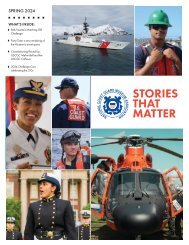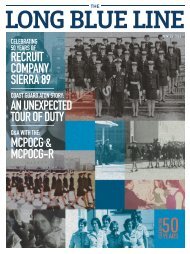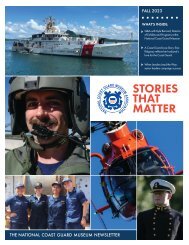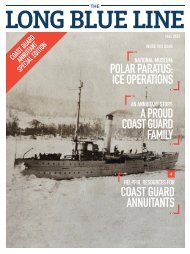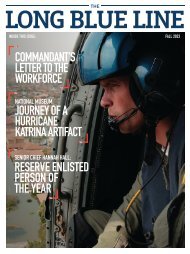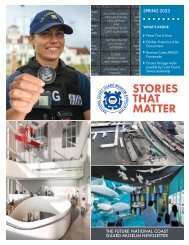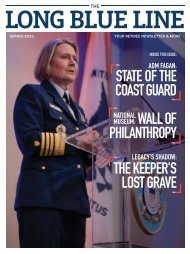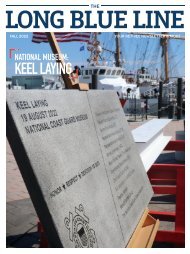The Long Blue Line (Winter 2021)
Quarterly magazine for retirees of the Coast Guard, Public Health Service, and National Oceanic and Atmospheric Association.
Quarterly magazine for retirees of the Coast Guard, Public Health Service, and National Oceanic and Atmospheric Association.
Create successful ePaper yourself
Turn your PDF publications into a flip-book with our unique Google optimized e-Paper software.
At the same time he rose through the officer ranks,<br />
Wilks became an accomplished Coast Guard<br />
aviator specializing in search and rescue missions.<br />
He qualified in over twenty different kinds of aircraft,<br />
including various fixed-wing and amphibious<br />
aircraft and single and multi-engine helicopters.<br />
Wilks served at several aviation units, including<br />
Coast Guard air stations in Italy, the Philippines,<br />
Hawaii, San Francisco, Massachusetts, Miami<br />
and New York. He received a Federal Aviation<br />
Administration award for a rescue performed out<br />
of Air Station Salem in Massachusetts and an Air<br />
Medal for a severe weather rescue flown out of<br />
Wilks blazed a trail for people<br />
of color in the Service and<br />
helped steer the Coast Guard<br />
toward greater diversity in the<br />
late-twentieth century.<br />
Air Station Barber’s Point in Hawaii. <strong>The</strong> Sikorsky<br />
Helicopter Corporation twice recognized him<br />
with the Winged-S Helicopter Rescue Award for<br />
daring missions demonstrating skill and courage<br />
in piloting a helicopter.<br />
As a Coast Guard aviation officer, Wilks broke<br />
even more color barriers. He was the Service’s<br />
first minority aviator and its first African American<br />
helicopter pilot. He later became the Coast<br />
Guard’s first minority aviation operations officer<br />
and first air station executive officer and the first<br />
recognized African American in the Service to<br />
achieve the rank of captain. And, in 1979, he<br />
became the first officer of color to command a<br />
Coast Guard air station.<br />
Bobby Wilks achieved great things as an aviator.<br />
However, his greatest contribution to the Coast<br />
Guard stemmed from his skills as a leader and<br />
motivator. Throughout his pioneering career, he<br />
remained an educator at heart, mentoring many<br />
of the next generation of Service leaders, such as<br />
flag officers Erroll Brown and Manson Brown. In<br />
1986, Wilks retired from the Service after a thirtyone<br />
year career.<br />
Photo of Commander Wilks, who<br />
served as operations officer as well<br />
as pilot at Barber’s Point Air Station.<br />
(U.S. Coast Guard Collection)<br />
THE LONG BLUE LINE WINTER <strong>2021</strong><br />
27



